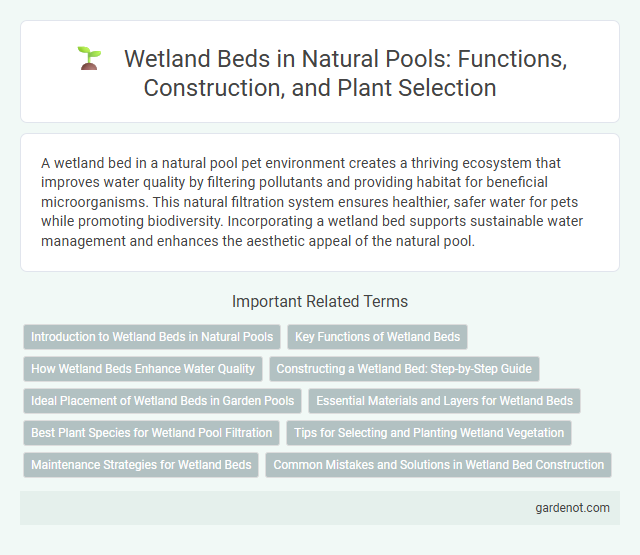A wetland bed in a natural pool pet environment creates a thriving ecosystem that improves water quality by filtering pollutants and providing habitat for beneficial microorganisms. This natural filtration system ensures healthier, safer water for pets while promoting biodiversity. Incorporating a wetland bed supports sustainable water management and enhances the aesthetic appeal of the natural pool.
Introduction to Wetland Beds in Natural Pools
Wetland beds in natural pools serve as essential biofilters, utilizing plants and microbial activity to purify water by removing nutrients and pollutants. These beds recreate the natural filtration process found in aquatic ecosystems, promoting water clarity and supporting biodiversity. Incorporating wetland beds enhances the ecological balance and sustainability of natural pool systems.
Key Functions of Wetland Beds
Wetland beds in natural pools play a crucial role in water filtration by trapping sediments, nutrients, and pollutants, enhancing overall water quality. They provide essential habitat for diverse aquatic plants and microorganisms that support ecosystem balance and biodiversity. These wetland systems also contribute to natural water circulation and oxygenation, promoting a healthy and sustainable aquatic environment.
How Wetland Beds Enhance Water Quality
Wetland beds improve water quality by filtering pollutants through their dense vegetation and microbial activity, which break down contaminants and excess nutrients. These natural filtration systems trap sediments and heavy metals, preventing them from entering the water column and maintaining ecosystem health. The root structures of wetland plants also promote oxygenation and support beneficial microorganisms that further purify the water.
Constructing a Wetland Bed: Step-by-Step Guide
Creating a wetland bed involves layering gravel and sand to ensure proper drainage and promoting native aquatic plants for natural filtration. Excavating the area to the desired depth and shaping gentle slopes helps mimic natural wetland ecosystems, enhancing water flow and habitat diversity. Incorporating a liner can prevent water loss while maintaining a balanced environment for beneficial microorganisms and wildlife.
Ideal Placement of Wetland Beds in Garden Pools
Wetland beds in garden pools thrive when positioned in areas with ample sunlight, ensuring optimal plant growth for natural filtration. Placing them on the shallow edges of the pool maximizes nutrient uptake and supports diverse aquatic ecosystems. Proper alignment with the pool's water flow enhances debris capture and maintains water clarity throughout the season.
Essential Materials and Layers for Wetland Beds
A natural pool's wetland bed requires essential materials such as gravel, sand, and specific aquatic plants to ensure effective filtration and water purification. The layered structure typically begins with a base of coarse gravel for drainage, followed by sand for fine filtration, and a top layer of nutrient-rich soil to support plant growth. Aquatic plants like cattails and reeds play a crucial role in oxygenating the water and removing contaminants, maintaining the ecological balance of the wetland bed.
Best Plant Species for Wetland Pool Filtration
Carex stricta, Pontederia cordata, and Typha latifolia are among the best plant species for wetland pool filtration due to their ability to absorb nutrients and trap sediments effectively. These plants enhance water quality by promoting microbial activity in their root zones, which breaks down contaminants and reduces pollutants. Incorporating a diverse mix of native wetland species optimizes filtration efficiency and supports a balanced aquatic ecosystem.
Tips for Selecting and Planting Wetland Vegetation
Selecting wetland vegetation for a natural pool requires choosing native species such as cattails, sedges, and rushes that thrive in saturated soils and improve water quality through natural filtration. Planting should be done in zones based on water depth, with emergent plants in shallow areas and submerged species in deeper zones to maximize ecological balance. Proper spacing and seasonal timing of planting enhance root establishment and support biodiversity, contributing to the pool's long-term health and clarity.
Maintenance Strategies for Wetland Beds
Regular monitoring of water quality and sediment levels in wetland beds is essential for maintaining a healthy natural pool ecosystem. Implementing selective vegetation management, including periodic removal of invasive species and promoting native aquatic plants, supports optimal filtration and habitat balance. Routine inspection and adjustment of water flow prevent stagnation and nutrient buildup, ensuring sustained ecological function in the wetland bed.
Common Mistakes and Solutions in Wetland Bed Construction
Common mistakes in wetland bed construction for natural pools include improper soil composition, inadequate layering, and poor water flow management, leading to reduced filtration efficiency and plant growth. Ensuring a well-graded substrate with a mix of sand, gravel, and organic matter enhances nutrient absorption and supports diverse aquatic plants. Proper design of water circulation and regular maintenance prevent stagnation and promote a healthy, balanced ecosystem within the wetland bed.
Wetland bed Infographic

 gardenot.com
gardenot.com